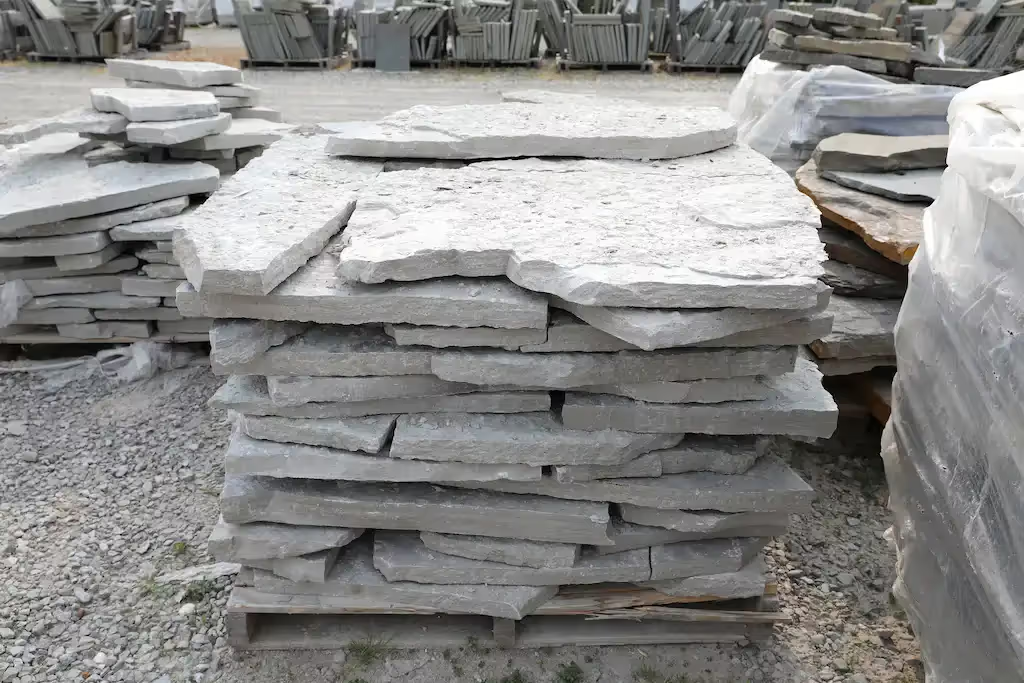- Stone Center
- Blog
How to Build Stone Steps That Last: From Planning to Finishing Touches
3/9/2025
8/11/2025
How to Build Stone Steps That Last: From Planning to Finishing Touches

Picture stepping through the back door of your house, down some classy stone steps, and onto a walkway that winds away among your lovely garden. If that's an idea that greatly appeals to you, you may be interested in learning how to build stone steps. Building stone steps may seem daunting, but with the right knowledge, tools, and action plan, it can be a fun and rewarding project that elevates the overall look and usability of your outdoor living space.
Our Stone Center experts will walk you through everything you need to know about natural stone steps as a DIY installation. From selecting the perfect natural stone steps and treads to mastering the construction techniques, we'll help you create stunning stone stairs that are both safe and add lasting value to your property.

Why Choose Natural Stone Steps for Your Garden or Outdoor Space?
Many advantages are offered by natural stone steps over regular pavers for your particular project.
- Durability: Natural stone is durable, resistant to any kind of weather, and so considered the best option for outside stairs, which will be used daily.
- Visual appeal: The unique textures and natural colors of stone create a beautiful focal point that enhances your outdoor space and can even boost your property value.
- Customization: Natural stone steps can be tailored to your specific project, ensuring optimal functionality, safety, and a design that complements your landscape.
- Slip-resistance: Stone's natural texture provides excellent slip resistance, making your steps safer in wet or icy weather — a major plus compared to standard pavers.
Essential Tools and Materials for DIY Stone Steps
To ensure your stone step project achieves professional results, gathering the right tools and materials is crucial for both safety and success.
Calculating the Rise & Run of Your Future DIY Stone Steps

Prior to starting the excavation process, it is crucial to engage in thorough planning and calculations. This step is essential to ensure the safety and ease of navigation.
Here are some key factors to take into consideration.
1. Figuring Out the Stones You Need
Planning how to build natural stone steps requires careful consideration of the overall design, as well as considering the construction practicalities.
- Thickness: Choose slabs thick enough to handle foot traffic and the elements.
- Depth: Ensure each step is deep enough for a comfortable stride.
- Number of steps: Calculate how many steps you'll need based on your project's height difference.
For outdoor steps, stones should generally be 6" and 7" in thickness, but this depends on the height and weight they will bear. Additionally, step depth should be between 12" and 18" to ensure a safe and comfortable pathway. With these specifications in mind, select stones that fit with the overall aesthetic of the entire yard and coordinate with any other hardscaping elements.
2. Measuring the Stone Staircase Run Length
The first step is to determine the distance for the overall run (horizontal length) of the staircase. Measure from the anticipated surface of the top step to the corresponding point above the bottom step (above the ground level perpendicular to it). This can be done using a ruler, shovel, or any other basic gardening tool long enough to reach up to the full height required.
3. Evaluating the Slope Height
When building natural rock steps, it's important to mark the spot on the rod that's level with the future top step's base. This will allow you to measure vertically from what will be the bottom step's base to the top step's base (total rise).
4. Calculating the Number of Stone Step Slabs

Divide your total rise by 6-8 inches (optimal step height) to calculate the number of steps needed. Next, divide the total run measurement by the number of steps calculated above to determine if the step depth falls within the recommended range of 12-18 inches.
If there's a bottom step that is level with the ground, subtract one from the total number of steps and adjust the tread accordingly to ensure it matches the rise.
How to Build Stone Stairs on a Slope: Step-by-Step Guide
Now that you've prepared your plan and gathered your materials, the exciting part begins — building your stone steps!
Here's a step-by-step guide to help you create your vision into a beautiful reality.
1. Mark and Plan the Layout
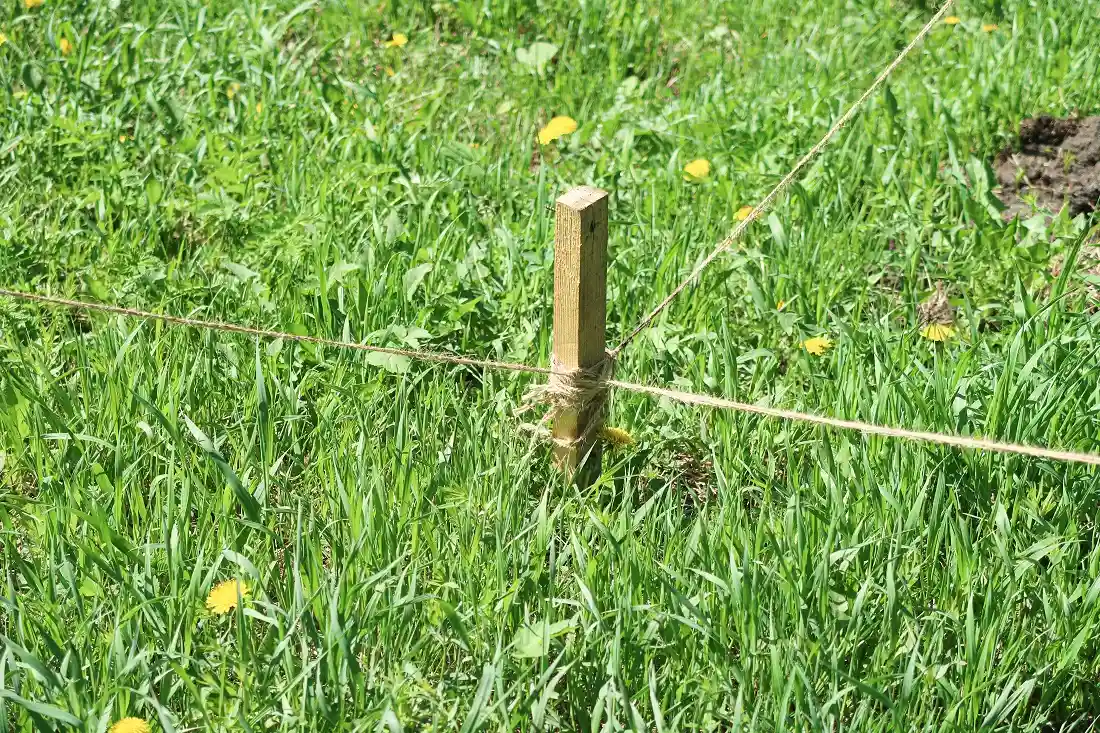
We've covered the importance of calculating rise and run measurements for your stone steps. Now use stakes and string lines to outline your staircase path on the slope.
Important note: Check with local building departments, such as Columbus Building & Zoning Services or Cincinnati Building & Construction Services, to ensure your project meets local codes and doesn't require permits.
2. Prepare the Foundation and Add a Base
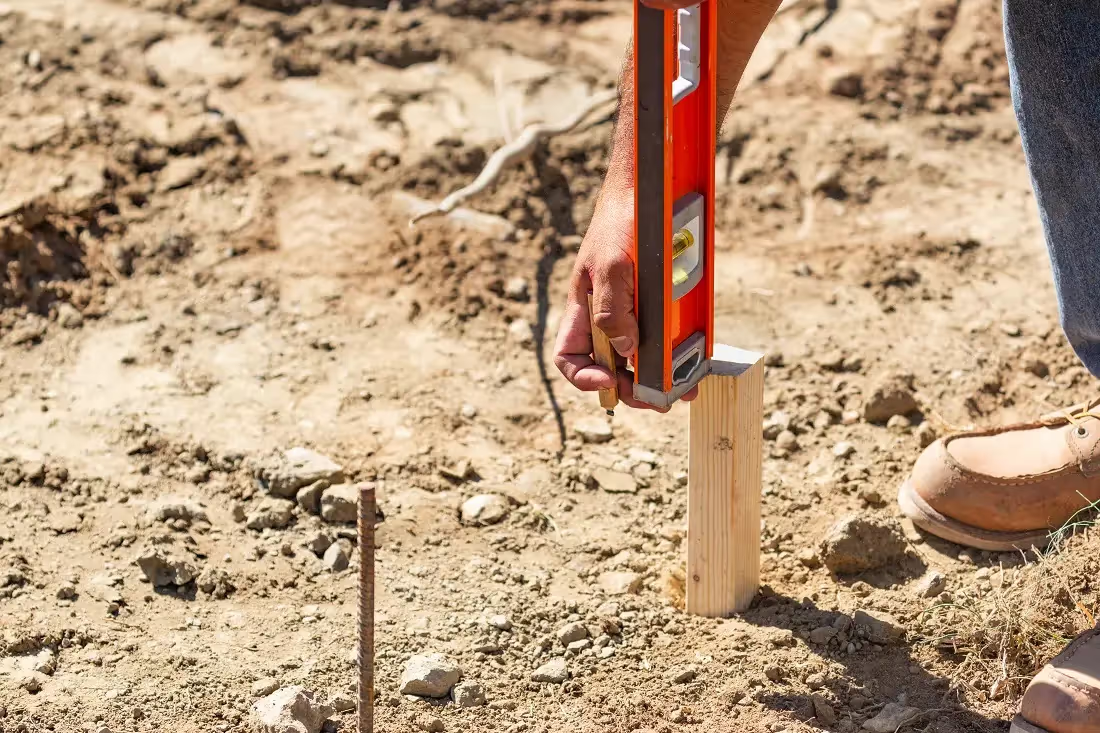
The first step is to dig out the surface area where the stair will be constructed to ensure it's flat, level, and stable. Remove all grass, plants, and debris that might interfere with the foundation. Dig the trench to a depth of 8-10 inches below the finished grade.
Once the surface is level, the space for drainage must be created by digging a trench at the base of the stairs. Add 4-6" crushed stone base and compact thoroughly (you can rent a compactor from Home Depot or similar stores). The crushed stone also provides a good base for the mortar, which will help secure the stone slab in place.
Pro tip: Consider installing a French drain if your slope has drainage issues. This prevents water from accumulating under your stairs and maintains structural stability.
3. Lay the First Natural Stone Step Slab
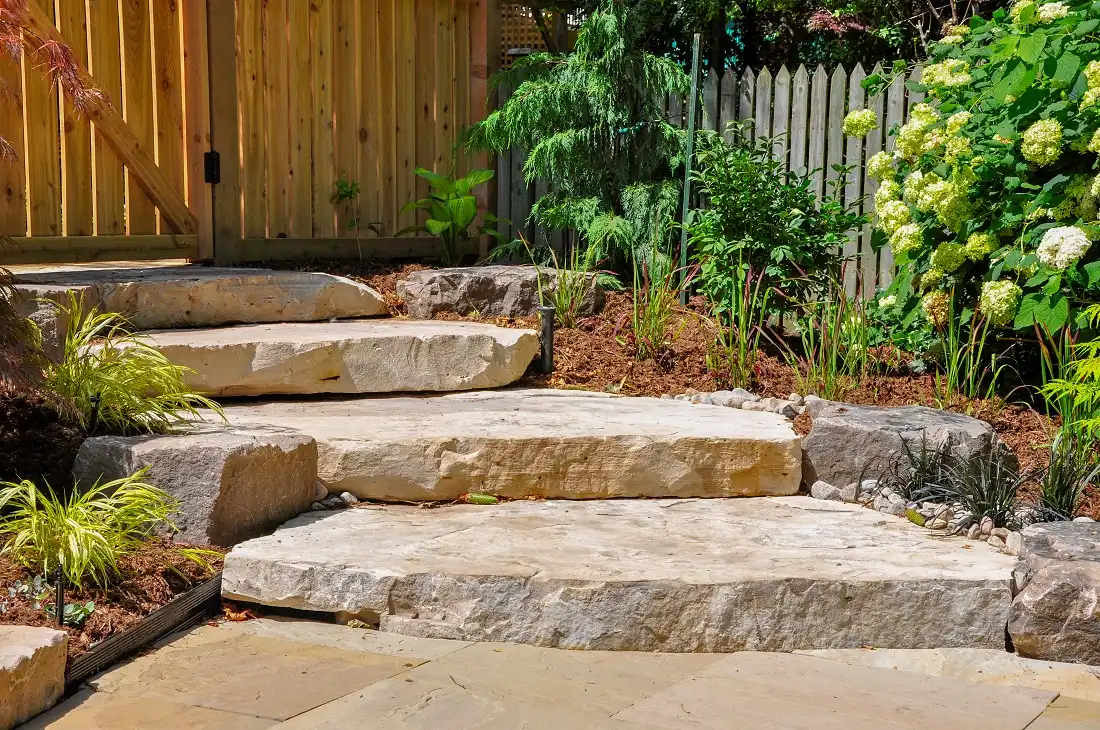
As soon as the foundation is ready, it's time to lay the first slab. Position the first stone carefully, ensuring it sits level from side to side. Ensure a slight forward tilt (~¼ inch/foot) for proper water drainage.
If necessary, a small DIY retaining wall can be built to ensure the slab is appropriately supported, especially on slopes.
4. Lay Out the Rest of the Steps from Bottom to Top

While carefully laying down each subsequent stone step, ensure that each step has a bit of overlap on the one below it and is aligned and leveled. Additionally, it is crucial to slightly tilt each step forward. This slight tilt helps the water to flow down the stairway instead of pooling on each step. Before moving on, make certain that each stone is even and level with the surrounding steps.
Backfill beneath and behind each stone. The gaps between each stacked stone can be filled with mortar, gravel, or even leftover stacked stone, depending on the design.
5. Secure the Stones
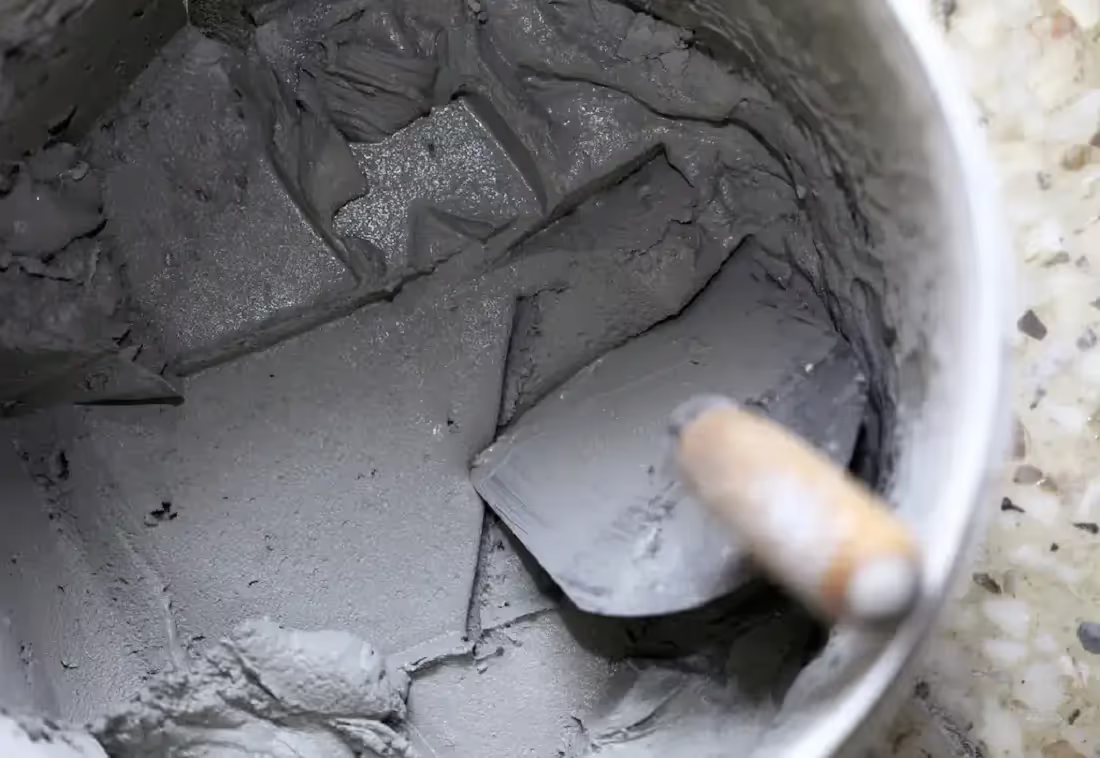
The gaps between the flat stones should be filled with mortar, adhesive, or polymeric sand, leaving enough time to dry thoroughly per the manufacturer's instructions. By taking these steps, each outdoor stone slab can be adequately secured for long-term, durable use.
6. Add Finishing Touches
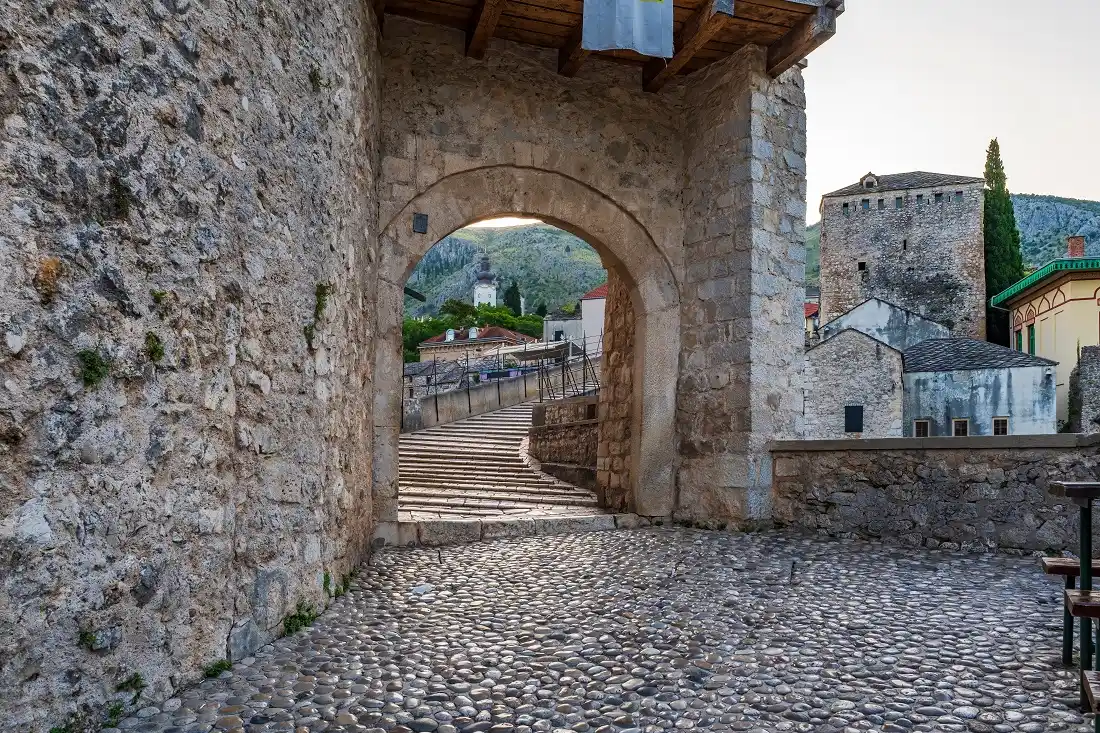
To enhance the aesthetic appeal of your outdoor space, consider incorporating decorative rock steps into your landscape design. Below, you'll find a few rock steps ideas to inspire your own creation.
- Flower beds: Enhance the aesthetic appeal of your outdoor space by planting vibrant and fragrant flowers on both sides of the stairway, adding a captivating touch of nature's beauty to your surroundings. You can also create beautiful borders using natural stone edging techniques.
- Arches: Consider constructing arches that frame the stone steps leading to the entryway, thereby enhancing its inviting and cozy atmosphere.
- Natural transition: Design your stone steps to blend beautifully with your landscape — try adding a border of mulch or low-growing plants at the edge for a natural transition.
Best Material Options and Cost Considerations
Consider using thick landscaping stones for your project, which will provide a sturdy, durable foundation. When building stone stairs on a slope, the material choice affects both initial costs and long-term maintenance requirements. Different types of natural stone offer varying benefits, and understanding these differences helps optimize your investment.
Below is a list of popular natural stones used in building outdoor stairs, along with their approximate cost per square foot:
While natural stone is more expensive up front than concrete alternatives, the superior durability, appearance, and property value benefits make it a smart long-term investment for most homeowners.
DIY Stone Steps vs. Professional Installation
Deciding whether to tackle stone step construction yourself or hire a professional contractor depends on your experience level, available time, and project complexity.
DIY Installation
- Pros: Significant cost savings on labor, complete control over project timeline and design details, personal satisfaction from completing the project, and flexibility to work at your own pace.
- Cons: Physically demanding, time-consuming, risk of costly mistakes, tool rental needs, and safety concerns with heavy materials.
Hiring a Professional
- Pros: Brings expert knowledge and proper construction techniques, completes the project more quickly, often includes a warranty on workmanship, and provides access to professional tools and equipment.
- Cons: Higher costs, limited creative input, scheduling delays, and possible miscommunication.
Regardless of your installation approach, selecting quality stone materials is a crucial aspect for project success. Consulting with a local natural stone supplier ensures you choose appropriate materials and provides expert advice for your specific application.
Keeping Your Stone Steps Beautiful: Simple Maintenance Tips
With a little regular care, your natural stone steps will stay in top condition for years to come. Here's how:
- Prevent buildup: Regularly sweep away dirt, leaves, and other debris to keep your steps looking clean.
- Rinse away grime: Use a hose or pressure washer to remove stubborn dirt and prevent stains.
- Stop weeds: Remove any weeds or grass growing between your stones to maintain a polished look.
- Check for damage: Inspect for loose or damaged stones and make repairs promptly to prevent further issues.
- Protect with sealer: If recommended for your stone type, apply a sealant periodically to help repel stains and weather damage.
Let Stone Center Make Your Stone Step Dreams a Reality!
Imagine the satisfaction of building beautiful stone steps that transform your outdoor space! With our expert tips, quality materials, and the right support, you can create a stunning and long-lasting feature that adds both style and safety to your home.
At Stone Center, we supply premium natural stone across Ohio, with locations in Columbus and Cincinnati. Whether you're building garden steps or formal staircases, our team offers expert guidance and a wide selection to bring your vision to life. Contact us today to get started!
FAQ
.avif)
Jon, the owner of Stone Center, is a knowledgeable expert in natural stone products, specializing in various types of stone for landscaping and architectural projects. Passionate about promoting the beauty and versatility of natural stone, Jon aims to use these blogs to inspire readers with creative ideas to upgrade their homes.
How much does it cost to get a stone restored?
How much you end up spending to restore stone varies on the type of stone, the technique, and the stone’s current condition. Stone in good condition will cost less to restore, whereas stone that has a lot of wear and tear may require a longer restoration.




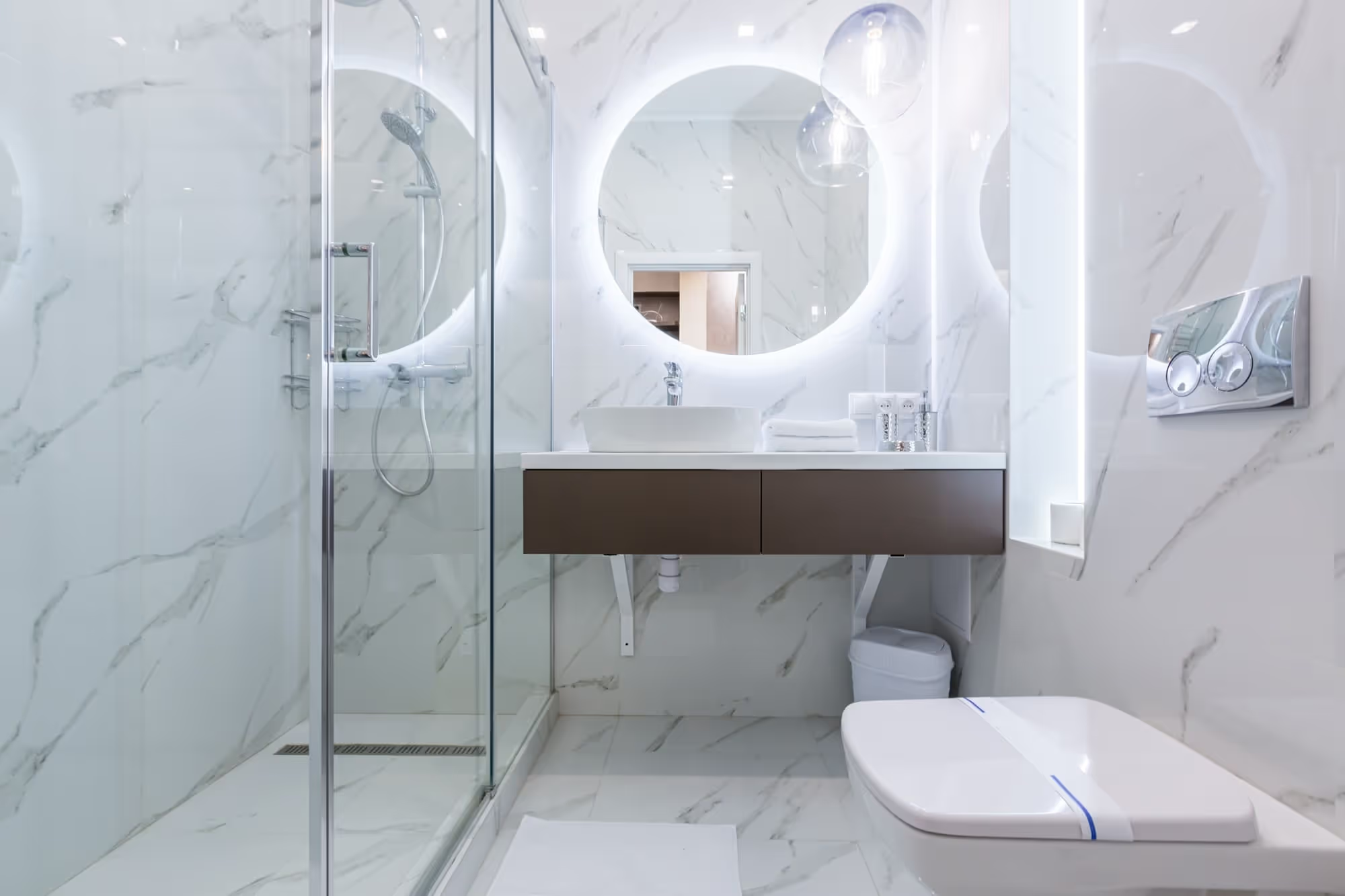

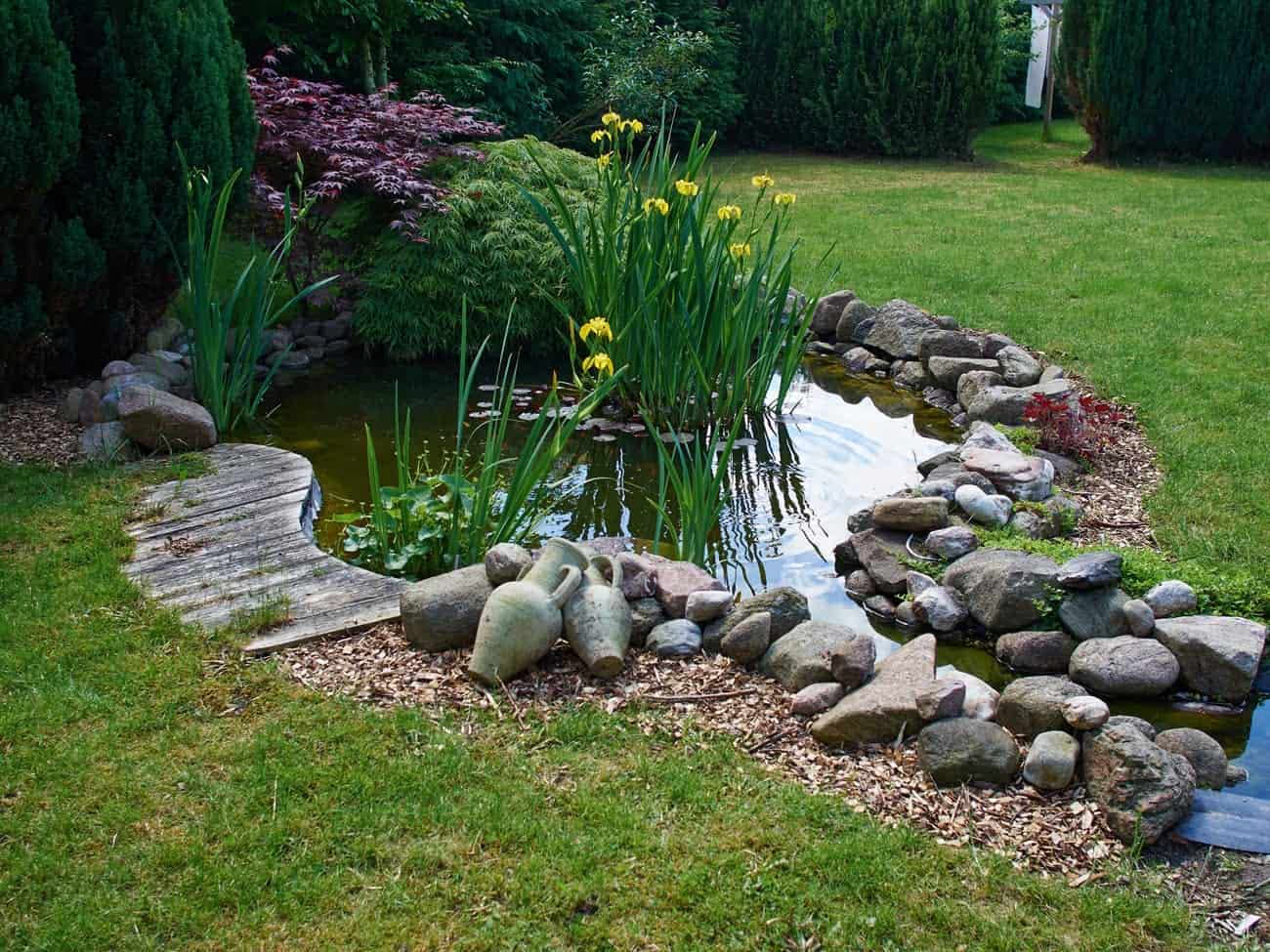
.avif)
.avif)
.avif)
.avif)

